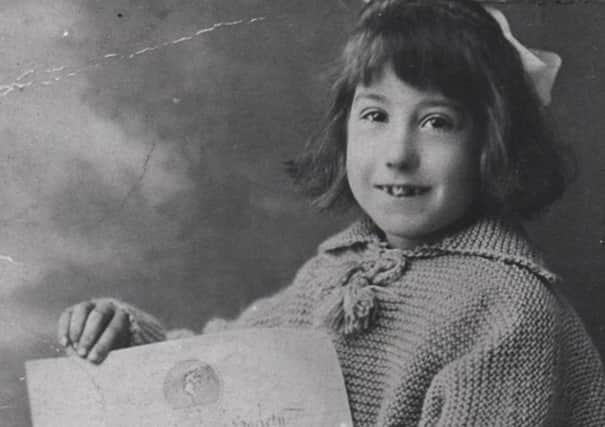The Nostalgia column with Margaret Watson: The tale of life-saving Laura


People like those working in the NHS and community care homes who are daily putting their lives at risk caring for others.
We might have stopped clapping for them outside our homes on Thursday nights but that doesn’t mean we have forgotten them.
Advertisement
Hide AdAdvertisement
Hide AdOver the years I have come across many such people who have risked their lives in various ways for others, and incredibly some of them have been children.


One of these was nine-year-old Laura Walmsley from Thornhill Lees, who dived fully clothed into the River Trent in 1919 to rescue a drowning child.
This happened while she was visiting relatives in Burton on Trent during the school holidays.
With no thought for herself, and although she didn’t know the child concerned, she just jumped in and managed to bring her to safety.
Advertisement
Hide AdAdvertisement
Hide AdLaura was awarded the Royal Humane Society Certificate for outstanding bravery, making her one of the youngest people in the country ever to receive it.
We know very little of the incident because it happened in Burton in Trent and Laura seldom spoke of it.
There was also another youngster from Dewsbury who in 1942 performed a similar rescue, and he too received the Royal Humane Society Certificate.
He was 16-year-old Allan Strafford, of Crackenedge Lane, Dewsbury, who rescued a little girl from drowning in the River Calder.
Advertisement
Hide AdAdvertisement
Hide AdThe girl in question was nine-year-old June Whitworth, of Pioneer Street, Thornhill Lees, who had been playing with friends on the banks of the Calder when she fell in.
She had been bending over trying to see some fish in the river near Lover’s Walk at Thornhill Lees, when she over-balanced and fell.
The current took her into the sluice gate where she became wedged and would have certainly drowned had it not been for the quick actions of Allan.
He was passing by with friends when he saw her fall in and he immediately sprang into action.
Advertisement
Hide AdAdvertisement
Hide AdHe balanced himself on the woodwork, and holding himself by his feet, dipped down and caught hold of her with one hand while at the same time clinging on to the supports with his legs and other hand.
He then shouted to June to release her hold which she did, and this enabled him to pull her through.
His two friends, Arthur Spence and Edward Crawshaw, helped him drag her to safety, where she was handed over to Mrs Ethel Brooke, who took her to her home, Upper Mill House, where she washed and dried her.
Allan and his friends then went back to work at Messrs Ashworth Ross and Company as if nothing had happened.
Advertisement
Hide AdAdvertisement
Hide AdChief Inspector Wilkinson said if Allan had not given immediate help to the girl by risking his own life, she would have drowned.
Allan was presented with his certificate by the Mayor of Dewsbury, Councillor John Chadwick, who said his courageous act was one of the finest examples he had ever heard.
He had shown courage, initiative, quick thinking, and quick acting, which had made him a pattern for the rest of the youth of Dewsbury to follow.
Laura Walmsley’s similar act of bravery in 1919 did not take place locally and therefore did not receive a great deal of publicity in her home town.
Advertisement
Hide AdAdvertisement
Hide AdFew knew of it, but some years ago I was able to learn more about Laura, from her son Nolan Walmsley, who kindly gave me an interview about his mother some 25 years ago.
Born in Thornhill Lees in 1910, Laura worked in local mills, served in the ATS during the war, had five children and lost two in infancy.
She remained married to the same man for over 40 years, and with great pride and ceremony moved into her first “new house” in School Lane, Dewsbury Moor, in 1950.
For the first time in her life she was living in a house with an inside bathroom and toilet and a garden front and rear, and felt like a millionaire.
Advertisement
Hide AdAdvertisement
Hide AdLaura, who died in 1990 aged 76, two years after her husband Robert died, worked all her life in local mills and rag warehouses.
During the war she served in the ATS as a cook in Lincolnshire where she met her husband, an ambulance driver in the Royal Auxiliary Service Corps.
There may be some who might think that Laura and Allan, like most people in this district, had lived ordinary and unremarkable lives.
But they were able to experience one special moment in their lives which marked them out as truly remarkable people. They saved someone’s life.
Advertisement
Hide AdAdvertisement
Hide AdLaura never boasted about her selfless act of bravery only to say that she knew that she had to do it.
I am sure that Allan felt the same because he certainly didn’t hesitate for one moment in risking his life for another.
Living in a town with a river flowing through it and dams and canals all around, there were many people who over the years carried out the same acts of bravery as Laura and Allan did.
They saved people from drowning, and in future weeks, I hope to write about some of these unsung heroes of the past.
I am indebted to Laura’s son Nolan for telling me his mother’s story all those years ago, and if he is still around, I hope he gets in touch.
Email [email protected] with your bygone stories.